Botox + Dermal Fillers: 7 Questions

Are there new wrinkles making an appearance on your forehead or around your eyes and mouth?
Botox and dermal fillers are the face of cosmetic injections, designed to smooth out fine lines—especially around the upper face. If you’re trying to regain your natural, youthful look, this stuff is for you.
Read on to find out the answers to seven major questions most people have about Botox and fillers.
How Does Botox Fight Wrinkles?
Botox, otherwise known as botulinum toxin A, previously only treated muscular conditions but now it is used to treat crow’s feet and reduce age-worn skin.
The injection weakens the muscles that would normally contract to cause wrinkles.
Can Botox Prevent Wrinkles?
Botox can be used as a preventive, sure. Anyone over the age of 18 can receive it. But it is recommended for individuals over 30 and no older than 60.
A responsible doctor will surely discourage the use of Botox before fine lines have set in.
How Do Dermal Fillers Work? and What’s the Difference Between Fillers and Botox?
Dermal fillers return volume and fullness to an aging face, while Botox smooths out wrinkles caused by the flexing of muscles on the forehead and around the eyes.
How Long Do Results Last?
Dermal fillers can last up to a year. A filler like Juvederm Vollure, though, will do its job for 15 to 18 months.
You can expect Botox to last somewhere between four and six months before having to return for another session.
Any Side Effects?
Yes. Patients can experience some bruising and a temporary headache following the procedure. But risk is minimal.
Are Patients Typically Satisfied?
Yes. Speaking with Dr. Nicole Hayre during a consultation at Cosmetic Dermatology Center will help you set realistic goal. Botox and dermal fillers are not going to provide the same results as a facelift, nor are they designed to.